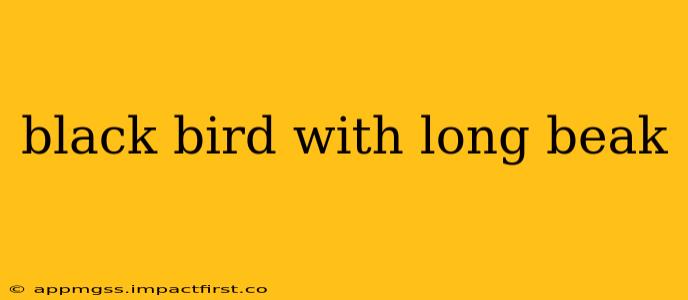The phrase "black bird with long beak" conjures up images of various intriguing avian species. Pinpointing the exact bird requires more information, but let's explore some possibilities and delve into the characteristics that might help you identify this fascinating creature. This guide will help you narrow down the possibilities and learn more about some likely candidates.
What Kind of Black Bird Has a Long Beak?
This question is a great starting point! Several bird species fit this description, and their habitats and behaviors significantly influence identification. The length of the beak, its shape (straight, curved, etc.), and the bird's overall size are crucial factors. Consider the location where you observed the bird – was it a forest, wetland, grassland, or coastal area? This geographical information is essential.
Could it be a Black Skimmer?
Black skimmers are immediately recognizable by their uniquely elongated lower mandible (the lower part of the beak). This lower beak is significantly longer than the upper and is used to skim the water's surface while flying, scooping up small fish. They are predominantly black, with white underparts, and are found along coastlines.
What About a Long-billed Curlew?
While not entirely black, the Long-billed Curlew has a striking, very long, slightly down-curved beak, a crucial adaptation for probing the mud and sand in search of invertebrates. They are largely brown and buff, but their long, dark beak can easily be the most striking feature. These birds are found in wetlands and coastal areas.
Is it a Black-necked Stilt?
Another possibility is the Black-necked Stilt. As the name suggests, it boasts a long, thin, and straight black beak. The bird itself is mostly black with long, pinkish legs, giving it a distinctive silhouette. They are typically found in shallow wetlands and mudflats.
How Big Was the Bird? Size Matters!
The size of the bird is a crucial factor in identification. Was it a small bird the size of a robin, or was it larger, perhaps the size of a crow or even bigger? The size helps narrow down the range of possibilities significantly. A larger black bird with a long beak could be something entirely different from a smaller one.
Where Did You See the Black Bird with the Long Beak?
The geographical location of your sighting is incredibly important. Different species of birds inhabit different regions. A bird found in North America will differ vastly from one seen in Africa or Australia. Knowing the region significantly narrows the search.
What was the Bird Doing?
Observing the bird's behavior provides valuable clues. Was it foraging on the ground, wading in shallow water, or flying low over the water? Different species have different feeding and habitat preferences.
What other features did you notice?
Beyond the beak and overall color, other characteristics, however subtle, can greatly aid in identification. Did the bird have any distinguishing markings, such as white patches, iridescent feathers, or a particular wing shape? Even details like its posture or flight pattern can be helpful.
By carefully considering all these factors – beak shape and length, size, location, behavior, and any additional features – you'll be much better equipped to identify that mysterious black bird with a long beak. Remember to consult field guides specific to your region for further assistance. Happy birdwatching!
